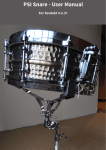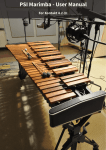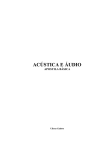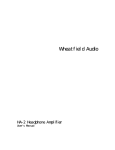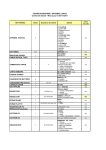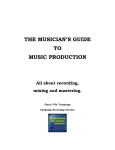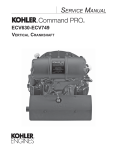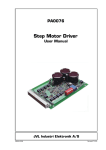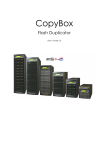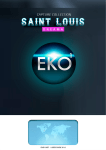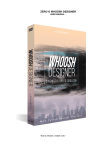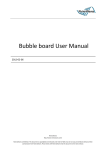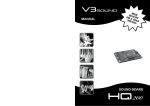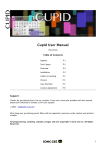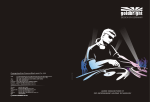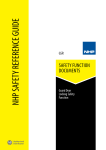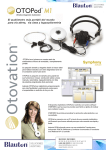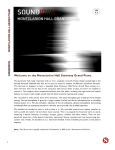Download Paper Stone - Creative Junk
Transcript
Creative Junk User Manual Overview Creative Junk is a 1.03GB, 2050 sample, experimental and tuned percussion collection, playable in the full version of Kontakt 4.0.2 and 5.0 It features 100 multi-sampled objects with up to 7 velocity layers recorded in 3 mic positions: ‘Close’ (Mono), ‘Overhead’ (stereo) and ‘Room’ (ambient stereo). The Instrument was recorded in the revered Studio 2 live room of Paper Stone Studios, Nottingham, England, using purely audiophile quality signal paths. Contents / Patches The collection is organised into 8 central Paper Stone Junk (PSJ) nkis PSJ Gamelan.nki (tuned objects) PSJ Kit.nki (reclaimed, broken and junk drums) PSJ Industrial.nki (large and metalic) PSJ Transients.nki (short and sharp attack) PSJ Jugs.nki (6 Jugs) PSJ Bottles.nki (3 Bottles) PSJ Foley.nki (Percussive SFX) PSJ Bounce.nki (Balls) And 12 stretch tuned NKIs, taking some of the more musical sounding objects and creating unique chromatic instruments. PSJ Hydrant.nki PSJ Metal Light.nki PSJ Colander.nki PSJ FryPan.nki PSJ Lid 1.nki PSJ Jug 1.nki PSJ Jug 2.nki PSJ Jug 3.nki PSJ Jug 4.nki PSJ Bottle 1.nki PSJ Bottle 2.nki PSJ Bottle 3.nki Also included are 3 tuned versions of the Main Gamelan, Jugs and Bottles NKIs PSJ Gamelan CT.nki PSJ Jugs CT.nki PSJ Bottles CT.nki All complete with an original user interface and advanced custom scripting engine. System Requirements > Full version of Kontakt 4.2.3 > 1.1 GB of Free Disc Space Installation The library is supplied as a single Zip file. This is a compressed folder that you can open using the built in tools on your computer. Open the file by double clicking and it will decompress the contents. Once decompression is complete you will have a single folder, this contains all the files needed to use the sample library. Simply copy this folder to the drive where you store your samples. For top performance it is recommended to keep sample libraries on a different drive to that of the OS and program files. Running the Library Once inside Kontakt, if you open the file tab in the browser window on the left-hand side you can browse through the instruments of the newly installed sample library. Just double click the NKI you wish to use and Kontakt will load it up. Alternatively you can drag the NKI from your standard OS explorer window into the Kontakt interface. You can also make use of Kontakt's Quick Load feature to make it even easier to load libraries into Kontakt: Please refer to the Kontakt user manual for more information. The Interface Mic Section 1 1 1. ‘Close', ‘Overhead' and ‘Room' rotary faders relate to the volume levels of each of the microphone positions. 2. Mic Global/Local button. This allows you to either control all the samples' mic positions together(when in global) or when clicked into Local, each note and it's related samples can have a different mic balance. 1 2 Instrument Section 3 4 3. Current sample. This displays which sample is currently being edited in the Instrument section. 5 4. Tune allows fine tuning of samples (hold shift for fine control) 5. Pan allows panning of samples 6 Transpose SEMI allows samples to be pitched from +12 to -12 in semitonal increments. 6 7 7 Transpose OCT allows samples to be pitched from -2 to +2 Octaves. 8 9 8. Attack controls the attack portion of a standard ADSR volume envelope for the selected sample. 10 9. Release controls the release portion of a standard ADSR volume envelope for the selected sample. 10. Instrument Global/Local Button: Selects whether all the samples in a patch are to be controlled together when altering the 'Instument' controls (when in Global setting) or when in Local setting each notes samples can be edited independently of one another. Effects Section 11 11. Effects readout: displays the current effect 12 none= Effect OFF Small= L224 ambience 0.25 (digital reverb) Studio= Music Studio A (real rooms) Church =Cathedral B (real rooms) S plate =L96 plate small A (digital reverbs) M plate = E252 2.2 s (real plate) 1 plate = L480 7.1 s (digital reverbs) FX verb 1= 1.s reverser, Opacity (special fx) FX verb 2 = anomalous rhythm (special fx / mix) FX verb 3 = rezo breath orven (unusual reverbs) Lo-fi = grammophon 3 12. Effect Controls: P-DEL: Effects the length of time befor the start of the reverb/effect LEVEL: Effects the volume of the effect SIZE: Effects the Length of the reverb/effect tail HPF: Allow you to shelve Low frequencies out of the effects send, thus 'thinning out' the reverb as desired. 13 13. Filter section ‘HPF' (high pass filter) allows bass roll off at 12db per octave between 20hz and 800z ‘LPF' (low pass filter) allows treble roll off at 12 db per octave between 20khz and 50hz 14. Filter Global/Local button. Allows filters to be applied over the entire NKI patch (in Global Mode) or individuallt to samples/notes (in Local mode) 14 Midi Control Simply right click on an interface function, select MIDI learn and send MIDI information from your control surface. Now record your desired MIDI automation into your DAW. FAQs Why Creative Junk? Our most ambitious, comprehensive and versatile offering to date, Creative Junk is a goldmine of unique hits, quirky sounds, and inspirational tones, all multi-sampled in our converted cinema auditorium live room. Sam Brown of Paper Stone Studios says: "When I’m writing I’m always looking for inspirational sounds, I want sounds that haven’t been created by conventional instruments and seek out unusual or abstract objects to manipulate and sample. I wanted to create a collection of these objects that would be sampled with multiple mic positions, and give them an interface that would allow each sound to be tuned filtered and sculpted independently of one another." Where Was The Instrument Recorded? Studio 2 of Paper Stone Studios, Nottingham, England. What Makes Studio 2 So Special? Studio 2 is a converted cinema auditorium dating back to 1914. It's floor space is large at around 1400 Sq. foot. The incredible acoustics of the room are down to 3 factors: An arched ceiling, which acts to reduce standing waves. A false floor covering the old staggered seating platforms, which acts as a bass trap. Engineered Acoustic treatment, in the form of rock wool screens and baffles. What Kit Was Used? We carried out extensive microphone shoot outs to ascertain the correct microphone, pre-amp, and positioning. We used the most effective resulting combinations, which were as follows: Close – either AKG C414 B-Uls, Senheiser MD-421, Audix D6, Coles 4038 / UA 610 pre/ Prism Conversion Stereo – Neumann KM184 pair / API preamps/ Prism Conversion Room – Neumann u87 pair / SSL preamps / Prism Conversion E.U.L.A. This End-User license agreement (EULA) is a legal agreement between you and Paper Stone Instruments for the Paper Stone Instruments product that this agreement accompanies; including computer software and associated media or multimedia, printed materials and electronic documentation. By installing or using this product you agree to be bound by the terms of the EULA. If you do not agree to the terms of this EULA you may not install or use the product. All audio samples provided with the product are the property of Paper Stone Instruments and are licensed to you, they are not sold. 1. Paper Stone Instruments grants the end-user (licensee) of the product the right to create finished musical works and performances using the audio samples and any other media or software included as part of the Paper Stone Instruments product. 2. The licensee may use the product for commercial purposes. 3. The licensee may alter the samples within the context of a finished musical work but may not distribute those altered samples outside of that musical context. 4. The creation of sound libraries in any form for commercial use or otherwise that use the Paper Stone Instruments audio or software, including single samples, loops, audio clips or similar is strictly prohibited. Violations will be prosecuted under local and international copyright law. 5. You may not under any circumstance make any part of the Paper Stone Instruments product available to others either by duplication, copy, distribution, transfer, upload, download, trade, resale, or loan. 6. The licensee may use this product on multiple computers under the following conditions: a. The use of multiple computers is part of a single audio workstation for the individual licensee. b. The licensee has two non-concurrent sites of work, such as a studio desktop and a laptop for live performance. 7. Paper Stone Instruments warrants and asserts that all audio samples, graphics, images, scripts, documents, and any other media included with the product is the sole property of Paper Stone Instruments and that Paper Stone Instruments has the authority to grant the rights in this EULA. 8. The user agrees to read the manual before seeking help or support from Paper Stone Instruments. 9. Paper Stone Instruments will not be responsible if the content of the product does not meet the particular purposes of the licensee. 10. It is the licensee's responsibility to check that the product is compatible with their computer system. 11. The product is licensed “as is”. Paper Stone Instruments will not be responsible for any loss incurred by the licensee from the direct or indirect use of the product. 12. If you have any doubts, concerns, or uncertainties about the terms in this EULA please contact Paper Stone Instruments before installing or using the product. Copyright Paper Stone Instruments ©2014






